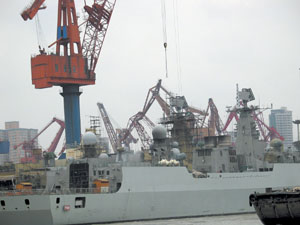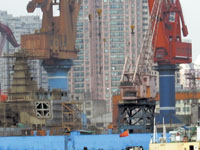China Builds Destroyers Around Imported Technology
 |
| Two Chinese Project 052B ships near completion in Shanghai. Note the Russian surface-to-air missile launcher aft and the three-dimensional radar forward. China is incorporating new foreign-designed technologies as its navy expands its mission. Photography by Kanawa. |
The most impressive new large guided missile destroyers (DDGs) of China’s Peoples Liberation Army Navy, or PLAN, are the showcases of new operations and responsibilities beyond traditional coastal roles. The ships’ new sensors, missiles and combat systems are mainly of Russian and Western origin. However, China now is faced with the challenge of operating and maintaining these advanced systems to create a credible threat to foreign navies in Far Eastern waters. This blue-water fleet primarily comprises ships that have been operational for years, but other more advanced ships are being built and may be deployed as soon as next year.
In December 1996, after three years of negotiation, China signed a deal with Russia to purchase two Sovremnyi destroyers. They were completed in the St. Petersburg Severnaya Verf Shipyard, with the first ship renamed Hangzhou and given hull number 136 when turned over to a Chinese crew in Russia in January 2000. The Chinese crew had arrived at the shipyard in May 1999 for training.
Every piece of equipment from hull, mechanical and electrical (HM&E) technologies to guns, sonar, communications, electronic countermeasures (ECM) and missiles are totally new to the PLAN. Of all the systems onboard DDG 136, only the anti-aircraft gun Bass Tilt and main battery Kite Screech fire control radars and the RBU-1000 antisubmarine warfare (ASW) rockets had been on PLAN ships. The KA-37 Helix ASW helicopter had been sold to China a few years earlier and was familiar to the Chinese, although Z-9 Chinese-produced copies of the Dauphin helicopter had served as their previous ship helicopters.
A mixed Sino-Russian crew manned the ship for its long journey from St. Petersburg to Dinghai, China. The second ship crew did not arrive at the shipyard until October 2000, and the ship was turned over in late November and transited to the PLAN East Fleet in December 2000 with 40 Russian crew and advisers aboard. This illustrates that the second ship crew trained in China and not in Russia as had the first crew. China is dependent on Russian advisers for training, operations and maintenance. These ships largely remain in the Russian support cocoon in Dinghai rather than at a fleet base.
Some reports indicate that both ships transited the Taiwan Straits just prior to an election in November 2000. Because only the DDG-136 had been delivered by then, the second DDG must have actually been an older Luhu or Luhai.
Isolation from other ships and crews hurts fleet integration and coordinated operations. In 2002, China ordered two more Sovremnyi to double the number of hulls in a few years. It is no coincidence that the Sovremnyi and Kilo submarine home bases are in an enclave of Russian support in an isolated area near the Eastern Fleet headquarters at Ningbo.
The 160-kilometer range supersonic antiship Moskit missiles carried by these destroyers—although an outdated design with a steam propulsion plant and minimal self-protection capabilities—are formidable. The Moskit missiles were not available until four months after delivery. These are nuclear capable, but Russia claims it did not provide nuclear warheads on the missiles, so China must have added its own nuclear warheads. These missiles are a new factor in any Taiwan area naval operations by other forces, including U.S. Navy aircraft carriers.
It is unlikely that Russian advisers would be onboard during actual combat operations against Taiwan and U.S. Navy air, surface and subsurface threats. PLAN officers and crew are not expected to be able to handle operations when under fire, sustaining hits and suffering system degradation or loss. This could include problems in night or rough weather environment as well. Because all of the combat systems, except for three noted, are modern Russian equipments, China has minimal capability even to repair peacetime losses in port.
The amount of at-sea time for PLAN destroyers is minimal compared with that of large navies. A couple of Ludas seem to be at sea on operations much more than the others. DDG-110 has been photographed many times at sea and was on a five-month South China Sea cruise in 1989, which is unusual because it was based out of Qingdao as the North Sea flagship from 1984 until 1992. DDG-105 is another ship seen at sea frequently even before it was selected to be the helicopter conversion Luda II.
The peak of readiness preparation and evaluation are fleet exercises. The PLAN averages four to five exercises per year, and about two-thirds are single fleet exercises, with the East Sea Fleet having about twice as many as the other two fleets. Certainly the new DDGs would be the heart of ASW and anti-air warfare exercises. Although China does not publicize accidents, it is known that Luda hull 160 from the South Sea Fleet was destroyed by an internal explosion near Zhanjiang in 1978.
The first high-technology destroyer combat system upgrades were performed on the last two Luda destroyers built in 1991 by the old Dalian shipyard, which has existed since 1885. Designated Luda III by the West, they were the test platforms for many of the modern imported combat systems to be on the new-construction Luhu and Luhai classes 10 years later. These were the first PLAN surface warships with a modern French DUBV-23 low-frequency active/passive sonar, French Vega II anti-aircraft gun fire control system, Castor II fire control radar, Italian Breda 40-millimeter/70-caliber anti-aircraft guns and TAVITAC combat direction system (CDS) by Thomson-CSF. Most systems were on later Luhu and Luhai new-construction warships. Prior to Luda III, in 1963 the Luda II was upgraded to DDG-105 and added a helicopter deck and hanger aft. This upgrade also replaced old semiautomatic 130-millimeter Russian gun turrets with new twin French Creusot-Loire fully automatic loading 100-millimeter guns.
The two new 4,200-ton Luhu DDGs are based out of the North Fleet headquarters of Qingdao. DDG-112 was built at Jiangnan Shipyard in 1991 and DDG-113 at nearby Quixu Shipyard in 1993, both in Shanghai. Nearly all imported systems of Luda III are in the Luhu vessels. Naval references all listed the French TAVITAC as the CDS on Luhu, but in fact both ships had the Italian Selenia Elsag IPN-10 CDS console. Italy had never acknowledged exporting this complex system to China.
The Luhai 6,000-ton Project 052 new-construction DDG-167 was built in the new Dalian shipyard, which is a very large and modern yard that was established in 1997 just west of the old Dalian yard. Besides the expected marine diesel workshops and varied repair capabilities, the new shipyard includes the Dalian Ship Design and Research Institute. The single Luhai DDG is based in Zhanjiang South Fleet Headquarters. This means that these personnel participate in all of the professional and technical events with the rest of the fleet ships and personnel. It would seem logical to base complex new ships near their shipyards for repair support parts and expertise, as the Ludas had been. In fact the Shanghai-built ships are based in the North Fleet and ships built in northern Dalian are based in the South Sea Fleet.
The four-month, 33,000-mile round-the-world cruise of Luda III DDG-166, Luhu-class DDG-112 and replenishment ship Nancang in 1997 was a success. They visited 10 nations and five continents during the cruise. Although the PLAN was established in 1949, its first foreign cruise did not take place until 1985. DDG-112 visited Vladivostok in 1996, but this trip is not a long transit.
Two new Project 052B DDGs, 168 and 169, are being built in Jiangnan Shipyard in Shanghai. The Jiangnan Shipyard has been building ships since 1865 and is one of the largest yards in China. DDG-168 was launched in September 2001, and 169 was launched in May 2002. These are incremental improvements of Luhai, but the new DDG-170 that was launched in April 2003 has major new systems. The most intriguing features of DDGs 170 and 171 are a four-panel phased-array radar that looks similar to Aegis SPY, a long-range antiship missile claimed by China to have SS-N-22 Moskit capabilities and a new Russian-type vertical launch system (VLS) forward. DDG-170 type ships will be based in fleet home ports, but vital Russian support for Klinok VLS and SS-N-22 weapon systems will be in Dinghai.
A comparison to U.S. Navy Aegis is inevitable, but Aegis was on Norton Sound for nine years of development testing prior to the first installation on the USS Ticonderoga (CG-47) 20 years ago. Developing the software for signal processing and tracking a hundred air, surface and submarine targets will take even longer for China. Integration to various indigenous ship guns and missiles and other sensors, as well as other ships’ data management and weapons, will take longer. These Chinese “Aegis” ships may be limited to 1940s era radar tasks of detecting and tracking air and surface targets for their own ship weapons. Further in the future will be an 8,000-ton DDG that is predicted to be a true area-control warship with additional Aegis capabilities. It is now in early construction stages in the new Dalian shipyard.
 |
| A close-up of a new Chinese DDG-170 under construction shows a gaping hole (lower left) where a phased array radar similar to the U.S. Aegis system is being installed. This ship also features a vertical launch system. Photography by Kanawa. |
All modern Chinese-built DDGs have the French DUBV-type sonars. Since France has sold only two systems to China, the additional systems must be produced under license in Chinese factories, so sailors should have in-country sources of parts and repair assistance.
Several of the upgraded DDGs have the Crotale surface-to-air missile (SAM) system by Thomson-CSF. The system maintenance and operation needs include not only the eight-barrel launcher, loader, magazine and missiles, but also associated Sea Tiger search radar and Castor missile guidance radar, infrared localizer and television tracker. After the Luda/Luhu, Chinese-built LN-60 missiles are unlicensed copies of Italian Aspide air-to-air missiles. The HQ-7 system designation indicates possible independence from France for the SAM systems.
France sold two TAVITAC CDS systems to China in 1990 for the two Luda III ships. Luhu had an Italian IPN-10 CDS observed in its combat information center, which was never openly sold to China. Although the type of CDS and country of origin is unknown on later ships, it is probable that there is no training, production rights or logistic support.
HM&E was the most critical failure area on modern submarines, so it must be an area of concern on large surface warships. Electrical source data for the Luda is not mentioned in reference sources, but Soviet Tallin data would be similar. The Tallin needed 1,200 kilowatts of power from two 400-kilo watt turbo generators and two 200-kilowatt diesel generators. By comparison, the Sovremnyi required 4,300 kilowatts. The Luda II and III equipment upgrades were power eaters, so additional diesel and/or turbo generators must have been added to meet the additional kilowatt needs. Because the Luhu, Luhai and newer DDGs use marine generators built in Chinese factories in Dalian, Shenyang or Shanghai, these should be easy to support and repair.
The new-construction surface ships with imported systems seem to have better marks than the PLAN submarine force. No DDGs have been lost or have had serious accidents; they are based far from their shipyards and have made successful distant blue water cruises. The new-construction DDG-170 Aegis ships will be long-term software headaches, but eventually the result should be a new level of command and control. Of course, final marks really are determined only in actual combat with enemy forces.
James C. Bussert is employed at the Naval Surface Warfare Center, Dahlgren, Virginia, where he works on surface-ship antisubmarine fire control systems with commercial off-the-shelf technology upgrades.




Comments